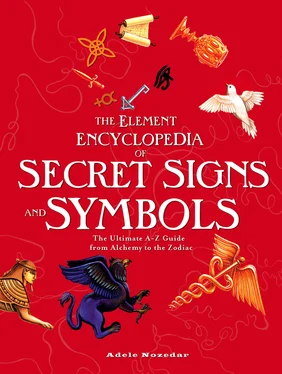12. 47th PROBLEM OF EUCLID, ALSO KNOWN AS THE BRIDE’S CHAIR
This mathematical theorem has been called one of the foundations of Freemasonry. It is called the 47th Problem for no more esoteric reason than Euclid published a book of theorems, of which this was number 47.
Its significance within Freemasonry is somewhat nebulous. However, the beginnings of the Fellowship in architecture and construction, and the usefulness of the 47th Problem as a measuring device, might give us the answer. The design features in Masonic regalia including lodge decorations and Masonic “jewels.”
The 47th Problem is also called the Egyptian string trick, and a practical demonstration in making of the shape illustrates its efficacy perfectly. Take a piece of string and tie 12 knots at exact intervals along the string. Then join the ends of the string, again making sure that the knots are evenly spaced. Hammer a stick into the ground. Put one of the knots over the stick. Stretch three divisions of knots and sink another stick into the ground at the point of the third knot. Then take a third stick and skewer it into the ground at the point where a fourth knot falls. This gives a triangle in the proportions of three, four and five, and further, the lines of the string can be extrapolated to make three squares of 9 parts, 16 parts, and 25 parts.
This simple device enabled the Egyptians to remeasure their fields after the Nile flooded every few years, washing away the boundary markers. The Egyptian string trick results in a perfect right angle, an essential device in the construction of a building, and as essential today as it was thousands of years ago, although methods of constructing the angle may have changed. Pythagoras traveled to Egypt and may have discovered it there, or he may have discovered it alone. Whatever the case, it is this geometrical solution that caused him to shout “Eureka.” In addition, it is said that 100 bulls were sacrificed in honor of the importance of this seemingly simple discovery, indubitably one of the secrets that was part of the hidden knowledge of the Master Mason; it may well have been one of the pieces of information for which Hiram Abiff was murdered.
In material terms, ashlar is the rough stone that comes straight from the quarry. In philosophical terms, to the Freemason, ashlar symbolizes the rough and imperfect state of man before he is rendered smooth and perfect in his ideally realized state. It relates to the alchemical idea of base matter that can be perfected through intellectual and spiritual realization.
14. POINT WITHIN THE CIRCLE
A seemingly simple symbol, the circle with a dot at its very center is a sign of birth and resurrection dating back to Egyptian times when it was used as an emblem of the Sun God, Ra. The symbol is associated particularly with the days of St. John the Baptist and St. John the Evangelist, which fall on the summer and winter solstices respectively.
Although it is stated time and time again that the symbols inherent within Freemasonry are nondogmatic and are as such open to interpretation, it is safe to say that the features of the actual temple form an important part of the secret signs of the Craft. The floor of the temple is no exception.
It is constructed of checkered tiles of black and white. These colors represent the duality of opposites; night and day, dark and light, male and female, fire and water, Earth and air, and all the other manifestations of this concept. In
Ancient Egypt, the colors were used as a reminder of the need to unify spirit and matter.
Abbreviated words, initials, and acronyms form a large part of Masonic ritual, since the pronunciation of certain words is believed to dilute their power and abbreviations are used instead. The abbreviation of GAOTU stands for Great Architect of the Universe, which in turn refers to God. Here there is a parallel to the nature of God as the builder or designer of the macrocosm, and the role of the Freemason as the designer of the microcosm.
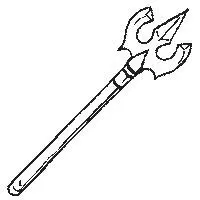
This is the magical weapon known as Odin’s Spear or Javelin. Like Mjolnir, the magical hammer belonging to Odin, Gungnir—whose name means “The Unwavering One”—has two very practical qualities that render it an essential tool in the arsenal of the powerful thunder god; it always hit its mark, and it always returns, like a boomerang, back to the thrower. As well as being a sacred object, there is a runic symbol, Gar, that also represents the Gungnir.
The halo, aureole, or aura all refer to an emanation of light, generally depicted appearing around the head. The halo is a symbol of spiritual sanctity or of divine grace, used in Christian iconography, for example, in pictures of saints. Although the halo is the sign that a person is blessed by the Divine, some people claim that they can actually see this phenomenon, and that the many colors of the aura that surrounds the entire body can be used as a diagnostic tool.
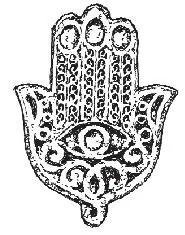
Also known as the Khamsa, the Hand of Fatima is named for Fatima Zahra, the daughter of Mohammed. It is a very ancient symbol, often used as a talisman, and in the Middle East it is ubiquitous, appearing in houses, shops, in taxis, and hotels. The hand is not really shaped like a normal human hand, but has two balanced thumbs and no little finger. The eye in its palm wards off the evil eye, so the Hand of Fatima is a double symbol of protection since the palm, held up, is a forbidding gesture. Khamsa actually means “five” and has relevance for both Muslims and Jews. Peace activists have adopted the Hand of Fatima in recent years; a reminder that the two faiths have many commonly shared beliefs.
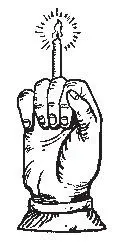
If magical charms have more efficacy the harder they are to construct or come by, then the Hand of Glory must be powerful indeed. Noticeably absent from New Age emporia, the Hand of Glory was popular with thieves during the sixteenth century. It was a light, or candle, made from the severed hand of a hanged convict. After this grisly relic was mummified by being embalmed in oils and special herbs, it was turned into a candle using tallow also made from a hanged corpse.
The Hand of Glory was the favored tool of thieves because, once alight, it was said to render household members unconscious. Therefore the thief could go about his nefarious activities undisturbed.
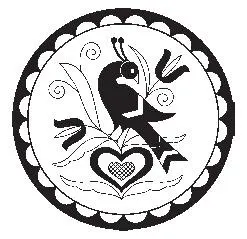
In the south-eastern part of Pennsylvania lives a population of European settlers, primarily from the Rhine area. These people come from different religious communities including Lutheran, Moravian, Quakers, Mennonites, and others. Some of these groups, despite their deeply held religious beliefs, are united by one thing; a thriving belief in witchcraft, also known as Hexerie, from the German, Hexe , meaning “witch.”
Читать дальше
